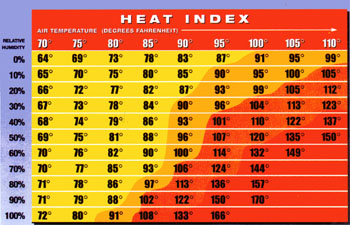Approximately 141 million Americans are living under heat advisories and warnings. Everywhere you read the news, more and more people are dying because of the heat. High temperatures have already broken records, or are on their way to doing so. Recently, in some parts of the country, to add insult to injury, there have been destructive and deadly thunderstorms sweeping through. According to the National Weather Service, heat waves kill more people in the United States than all of the other weather related disasters combined. The ten-year average – (1997-2006) for heat related deaths in the U.S is 170 in a typical year. I hope 2011 doesn’t break that record, but I fear that it may.
We often think, “It’s not the heat, it’s the humidity.” Actually, it’s both. Heat waves form when high pressure aloft strengthens and remains over a region for several days up to several weeks. More common in summer, the jet stream follows the sun. Summertime weather patterns are generally slower to change than in winter. This results in a mid-level high pressure moving slowly. Under high pressure, the air sinks toward the surface. This sinking air acts as a dome capping the atmosphere. This darned cap helps to trap heat instead of allowing it to lift. Without the lift, there is little or no convection and therefore little or no cumulus clouds, with minimal chances for rain. The end result is a continual build-up of heat at the surface that we experience as a heat wave. Thanks to the National Weather Service for this information. I have trouble even following the weatherman when it comes to the technical stuff. But one thing we all know for sure: IT’S HOT!

The National Weather Service wants to protect life and property by explaining a measure of how the hot weather “feels” to the body. The Heat Index shows a table, which uses relative humidity and dry bulb temperature to produce the “apparent temperature” or the “temperature the body “feels”. Remember, these values are for shady locations only. Exposure to full sunshine can increase heat index values by up to 15 degrees F. Strong winds, especially with very hot, dry air, can be extremely hazardous, as the wind adds heat to the body.
The best advice is to stay inside where it’s cool as much as possible until the weather cools down. Hopefully, that’s only a few weeks away. But for those souls who must be outside doing their job, practicing sports, marching in bands, getting ready for school….hopefully, their leaders will do all they can to keep them hydrated. They must have plenty of water breaks, and when possible, let teams and bands do the practicing at night under lights. It would be worth more to spend a little money on lights than have a student collapse from the heat, or worse. So far, the U.S. has had reported deaths of elderly, persons who did not have any type of coolers, children left in cars, athletes, and a high school coach. The numbers change so often, I wouldn’t even try to report how many so far throughout the country have died from the heat.
Just pay attention to what your weather forecast is, and do all you can to protect yourself from the heat. Wear a hat, lots of sunscreen, and anything else that will keep you cool. Don’t walk on hot pavement in sandals. One lady received 2nd degree burns on both feet when she walked to the grocery store in flip-flops. It was reported that the pavement was 145 degrees at the time!
Stay cool, pray for rain, and hope that we have an early fall!
Also remember that signs of heat stroke are dry mouth, ceasing sweating, dry mouth, blurred vision and irriablilty and confusion. A person suffering heat stroke may not realise they are affected.
If you ignore signs of heat stroke you can die. For hot humid climates you can drink up too ten litres of water a day just to stay cool.